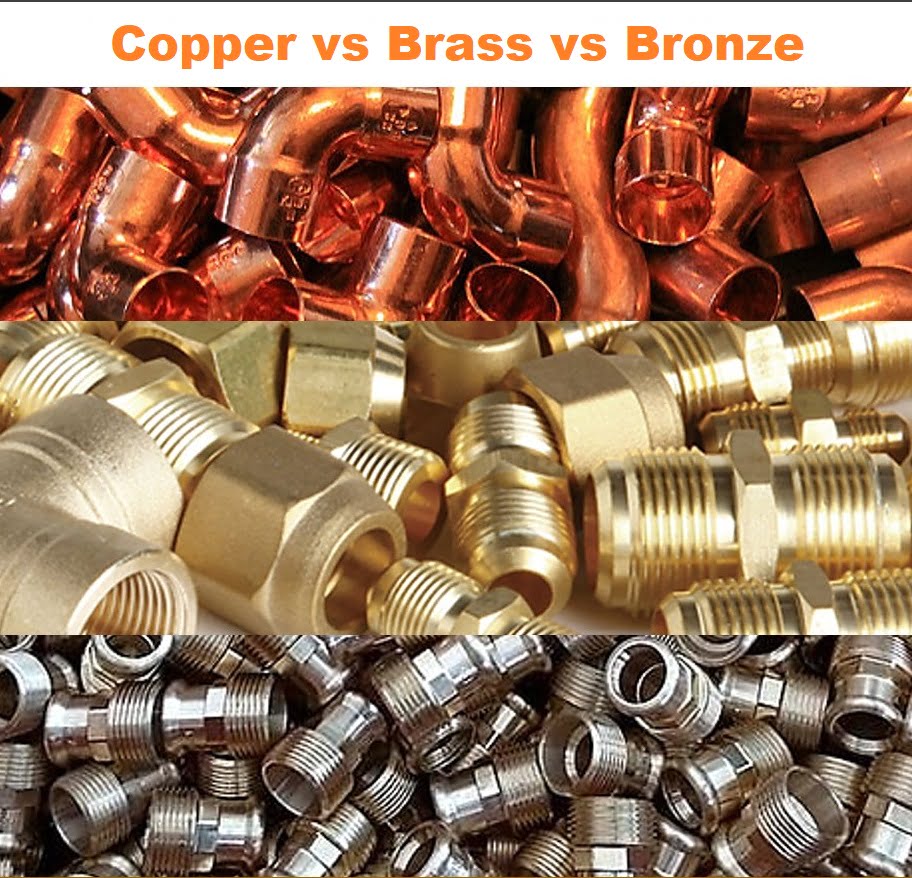Bakır ve pirinç ve bronz: kapsamlı bir karşılaştırma

Bakır, pirinç ve bronz, inşaattan elektroniklere kadar çeşitli uygulamalarda en önemli ve yaygın olarak kullanılan metallerden üçüdür. Bu alaşımların her biri, onları belirli kullanımlara uygun hale getiren benzersiz özelliklere ve özelliklere sahiptir. Bu metaller arasındaki farklılıkları anlamak, projeniz için doğru materyalin seçilmesine yardımcı olabilir. Bu makale bakır, pirinç ve bronzun bileşimini, özelliklerini, avantajlarını ve ortak uygulamalarını araştırmaktadır.
1. kompozisyon
Bakır
- Kimyasal sembol: Cu
- Kompozisyon: Bakır, 29 atomu ile saf bir metaldir.
- Ortak alaşımlar: Bakır genellikle farklı bakır alaşımları oluşturmak için çinko, kalay veya nikel gibi elemanlar ile alaşımdır.
Pirinç
- Kimyasal sembol: Cuzn
- Kompozisyon: Pirinç öncelikle bakır (tipik olarakU-95) ve çinko (%5-45) alaşımıdır.
- Ortak alaşımlar: İşlenebilirlik veya korozyon direnci gibi belirli özellikleri arttırmak için kurşun, kalay veya alüminyum gibi diğer elemanlar eklenebilir.
Bronz
- Kimyasal sembol: Cusn
- Kompozisyon: Bronz öncelikle bakır ve kalay alaşımıdır (yaklaşık% 60-90 bakır ve% 10-40 kalay).
- Ortak alaşımlar: Belirli özellikleri iyileştirmek için alüminyum, manganez veya fosfor dahil diğer elemanlar dahil edilebilir.
2. Özellikler
Bakır
- Renk: Kırmızımsı kahverengi renk tonu.
- İletkenlik: Mükemmel elektrik ve termal iletkenlik.
- Korozyon Direnci: Özellikle deniz ortamlarında korozyona karşı iyi direnç.
- Süneklik: Son derece sünek ve dövülebilir, kapsamlı şekillendirme ve şekillendirme sağlar.
- Kuvvet: Güçlü, ancak alaşımları kadar güçlü değil.
Pirinç
- Renk: Sarımsı-altın görünümü.
- İletkenlik: Saf bakır kadar yüksek olmasa da iyi elektrik iletkenliği.
- Korozyon Direnci: Korozyona karşı orta derecede direnç; bir patine geliştirebilir.
- Süneklik: İyi süneklik sunar, ancak çinko içeriğine bağlı olarak değişir.
- Kuvvet: Özellikle yüksek çinkili alaşımlarda genellikle saf bakırdan daha güçlü.
Bronz
- Renk: Kırmızımsı kahverengi veya altın renkli görünüm.
- İletkenlik: İyi elektrik iletkenliği, ancak bakır ve pirinçten daha düşük.
- Korozyon Direnci: Özellikle deniz suyunda mükemmel korozyon direnci; pirinç kadar kolay kararmaz.
- Süneklik: Adil süneklik, bakır kadar olmasa da.
- Kuvvet: Özellikle yüksek tinli alaşımlarda, tipik olarak bakır ve pirinçten daha güçlü ve daha sert.
3. Avantajlar
Bakırın avantajları
- İletkenlik: Yüksek iletkenlik nedeniyle elektrik uygulamaları için idealdir.
- Korozyon Direnci: Korozyonun endişe kaynağı olduğu ortamlarda etkilidir.
- Dövülebilirlik: Çeşitli formlarda kolayca şekillendirilir, bu da üretim için çok yönlü hale getirir.
- Geri dönüştürülebilirlik: Mülk kaybı olmadan son derece geri dönüştürülebilir.
Pirinç avantajları
- İşlenebilirlik: Daha yumuşak doğası nedeniyle bakırdan daha kolay.
- Estetik Çekicilik: Çekici görünüm, genellikle dekoratif uygulamalarda kullanılır.
- Anti-bakteriyel özellikler: Bakterilere karşı doğal direnç, sıhhi tesisat ve bağlantı parçaları için uygun hale getirir.
- Çok yönlülük: Birçok sınıfta mevcuttur ve belirli uygulamalar için uyarlanabilir.
Bronz avantajları
- Dayanıklılık: Mükemmel güç ve aşınma direnci, ağır hizmet uygulamaları için uygun hale getirir.
- Korozyon Direnci: Deniz ortamlarında olağanüstü performans, gemi inşa ve kıyı uygulamaları için ideal.
- Düşük sürtünme: Daha düşük sürtünme özellikleri, yatak ve burçlar için uygun hale getirir.
- Kıvılcım çıkarmaz: Patlayıcı ortamlarda kullanım için güvenli.
4. Ortak uygulamalar
Bakır uygulamaları
- Elektrik kabloları: Mükemmel iletkenliği nedeniyle elektrik sistemlerinde yaygın olarak kullanılmaktadır.
- Sıhhi tesisat: Korozyon direnci nedeniyle borular ve bağlantı parçaları için yaygın olarak kullanılır.
- Elektronik: Devre kartlarında ve konektörlerde kullanılır.
- Çatı kaplaması: Estetik çekiciliği ve dayanıklılığı için mimari uygulamalarda kullanılır.
Pirinç Uygulamaları
- Müzik aletleri: Akustik özellikleri nedeniyle pirinç aletler için yaygın olarak kullanılır.
- Bağlantı parçaları ve vanalar: İşlenebilirliği için sıhhi tesisat ve ısıtma uygulamalarında kullanılır.
- Dekoratif öğeler: Dekoratif hırdavat ve takılarda sıklıkla kullanılır.
- Otomotiv Bileşenleri: Mukavemet ve dayanıklılık nedeniyle dişlilerde, bağlantı elemanlarında ve burçlarda kullanılır.
Bronz Uygulamaları
- Denizcilik Donanımı: Mükemmel korozyon direnci nedeniyle tekne donanımlarında ve pervanelerde kullanılır.
- Heykeller ve Heykeller: Estetik çekiciliği ve dayanıklılığı nedeniyle sanatta yaygın olarak kullanılır.
- Rulmanlar ve Burçlar: Düşük sürtünme özelliğinden dolayı makinelerde kullanılır.
- Tarihi Paralar: Dayanıklılığı ve korozyona karşı dayanıklılığı nedeniyle madeni para basımında kullanılır.
5. Farklılıkların Özeti
| Mülk | Bakır | Pirinç | Bronz |
|---|---|---|---|
| Kompozisyon | Saf bakır | Bakır ve çinko | Bakır ve kalay |
| Dış görünüş | Kırmızımsı kahverengi | Sarımsı-altın | Kırmızımsı-kahverengi/altın |
| İletkenlik | Harika | İyi | İyi |
| Korozyon Direnci | İyi | Ilıman | Harika |
| Süneklik | Son derece sünek | İyi | Adil |
| Kuvvet | Güçlü | Genellikle daha güçlü | Daha güçlü |
| İşlenebilirlik | Ilıman | Yüksek | Ilıman |
| Ortak Kullanımlar | Elektrik, sıhhi tesisat | Müzikal, bağlantı parçaları | Denizcilik, rulmanlar |
6. Sonuç
Bakır, pirinç ve bronz, çeşitli uygulamalara hitap eden farklı özelliklere sahip temel malzemelerdir. Bakır, elektrik iletkenliği ve korozyon direnci açısından üstündür, bu da onu elektrik ve sıhhi tesisat uygulamaları için ideal kılar. Pirinç, işlenebilirliği ve estetik çekiciliği nedeniyle sıklıkla dekoratif ve müzik aletlerinde kullanılır. Bronz, özellikle deniz ortamlarında dayanıklılık ve mükemmel korozyon direnci sunar.
Doğru malzemenin seçilmesi, mukavemet, korozyon direnci, görünüm ve işlenebilirlik dahil olmak üzere uygulamanın özel gereksinimlerine bağlıdır. Bakır, pirinç ve bronzun benzersiz özelliklerini anlamak, mühendislik, inşaat ve sanatsal çabalarda bilinçli kararlara izin verir. Bu metallerin her birinin kendi güçlü yönleri vardır, bu da onları modern dünyada vazgeçilmez hale getirir.
